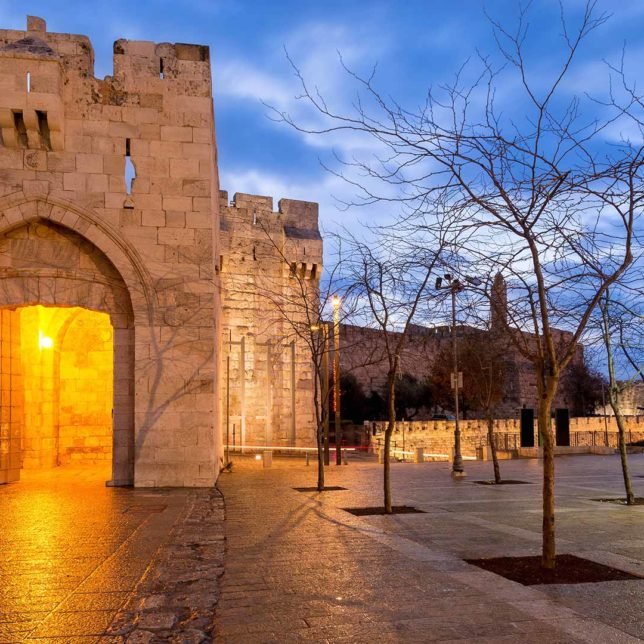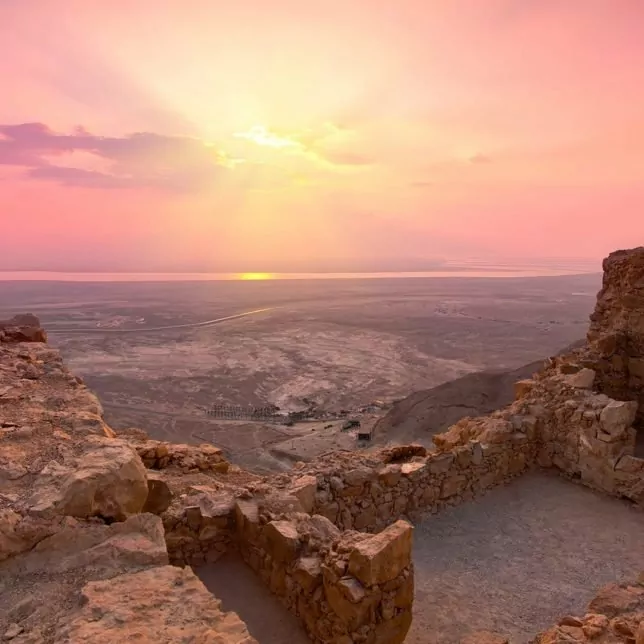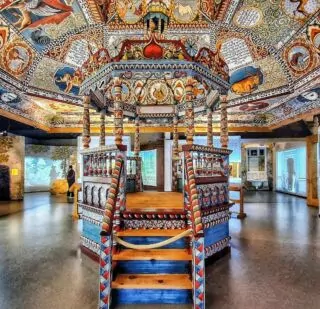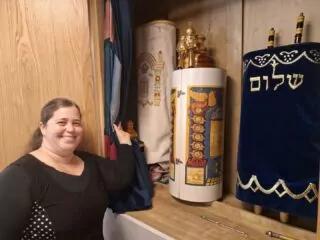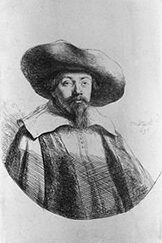
Rabbi Menasseh ben Israel 1604-1657
Little-known today, Rabbi Menasseh ben Israel was, during the 17th century, perhaps the most famous Jew in the world. He was born in Portugal in 1604 to parents who had been forced through torture to convert to Catholicism. Accused of remaining secretly Jewish, the family fled to Amsterdam, arriving in 1610. By the age of 18, Menasseh (as he was generally known) was a rabbi, his sermons drawing even non-Jews to the synagogue. A true Renaissance man, he was also a printer, scholar, Kabbalist, teacher, businessman, and diplomat.
It was Menasseh’s willingness to explain mystical Jewish concepts to non-Jews that brought him both international celebrity and criticism from other Amsterdam rabbis. Menasseh was convinced that redemption relied on Jews living in every part of the world. Only then could the scattered Jews be re-united and the Messiah come. His belief that this process was underway was strengthened by claims that Andes Indians in South America were part of the Lost Tribes of Israel.
As Menasseh wrote in his book The Hope of Israel, what was now needed was for Jews to live again in England, from where they had been banished for over three hundred years. This idea inspired considerable interest in England, where Christian millenarian beliefs that Jews could help bring about the second coming of Christ were powerful. Many were also impressed by his claim that Jews would bring “merchandising and profit” to the country.
In 1655, Menasseh met in London with Oliver Cromwell, the ruler or Lord Protector of Britain. Cromwell opened the way toward gradual Jewish readmittance to Britain but, to Menasseh’s disappointment, stopped short of issuing immediate, formal, written permission. Menasseh then faced personal tragedy, returning to Amsterdam in 1657 to bury his son Samuel. He died shortly afterward.
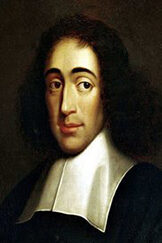
Baruch Spinoza 1632-1677
Often described as the first secular Jew and the father of biblical criticism, Baruch Spinoza was one of the most radical and influential philosophers of the modern age. His family members were Marranos, Jews who had been forcibly converted to Christianity during the Portuguese Inquisition (1536). They re-embraced Judaism when they came to more-tolerant Amsterdam, the city where Baruch was born in 1632. Baruch’s mother died when he was young. His father was a merchant and a pillar of the city’s flourishing Portuguese-Sephardi Jewish community.
From an early age, Spinoza was skeptical of traditional religious beliefs, but he remained outwardly observant while his father was alive. However, at age 23 and before he had published any of his writing, Spinoza was cursed by and excommunicated from the Jewish community for (undefined) “abominable heresies” and “monstrous deeds.” All Jews, including his family, were forbidden from having any contact with him. It was not unusual for Amsterdam Jews to be placed in cherem (excommunicated). What was less common was the harsh language of the ban and that it was never lifted. Also uncommon was that the cast-out Spinoza neither repented nor converted to Christianity. He was without a religious community.
Expelled from Amsterdam by municipal authorities, Spinoza settled in The Hague where he associated with freethinking Christian scientists, philosophers, and theologians. He lived frugally, worked as a lens grinder, thought, and wrote. Ironically for someone condemned as a heretic and atheist, he was often described as having a “saintly” character and unimpeachable ethics. He lived his belief in benevolence and tolerance.
Nonetheless, his ideas were revolutionary, and he published little out of fear of reprisal. His key works were his Theological-Political Treatise, released anonymously in 1670, and his magnum opus Ethics, published after his death. These outlined his claim that God and Nature are two names for the same thing and that “God’s decrees and commandments and consequently God’s providence are in truth nothing but Nature’s order.” Spinoza’s God did not watch over the world or intervene through miracles or punishment and Spinoza rejected the idea that the human soul was immortal. Spinoza was the first to argue that the Bible was a human document rather than the word of God and should be studied like any other book, with close attention to errors, inconsistencies, and the motives of its authors. His political views were also ahead of their time. He championed democracy and freedom of thought while opposing monarchical and aristocratic rule.
The opposition was ferocious. Spinoza’s work was denounced as “forged in hell” and banned in the Dutch Republic and by the Catholic Church. Nonetheless, when he died at age 44, apparently from complications caused by inhaling glass dust from the lenses he ground, his influence was only beginning. He would, in following centuries, be acclaimed as one of the most important of all modern philosophers, and the man who “laid the groundwork for subsequent liberal, secular, and democratic thinking.”
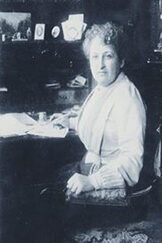
Aletta Jacobs 1854-1929
Aletta Jacobs, a pioneer in birth control, women’s suffrage, and peace activism, was born in 1854 in the small town of Sappemeer. She was, from childhood, determined to follow her father into the medical position. Educational opportunities for girls were severely limited but, with support from the liberal Jewish community, she became the first female student at the University of Groningen and in 1879, the Netherlands’ first female physician. Inspired by the work of British radicals, she established a medical practice in Amsterdam with free clinics for women on issues such as birth control and hygiene. She met concerted opposition from religious leaders and other doctors, especially after she introduced the pessary (diaphragm) into the Netherlands.
As early as 1883, Jacobs was attempting unsuccessfully to register to vote. By the turn of the century, she was an internationally prominent women’s suffragette. In 1919, the Netherlands joined many European nations in granting women the right to vote. Jacobs also took the feminist struggle to Africa, the Middle East, and Asia, including a 16-month visit in 1911-12.
In 1914, Jacobs led women’s networks in protesting against World War I. Once again, she was undeterred by the enormous opposition to her stance, and in 1915 she travelled to the US to unsuccessfully call on President Woodrow Wilson to mediate an end to the war. She was a founder of the Women’s International League for Peace and Freedom. Her last years were difficult. Her husband and their only child had died earlier, and she suffered from health and financial problems. Nonetheless, she continued to travel, write, and agitate, and was acclaimed as a major figure in Dutch and international feminism. Aletta Jacobs died in 1929.
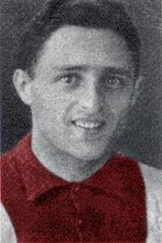
Eddy Hamel 1902-1943
Edward (Eddy) Hamel was born in New York City. He moved to the Netherlands as an infant. Hamel spent his teenage years playing lower league soccer before coming to the attention of the legendary Ajax Amsterdam team through unorthodox means: he would kick soccer balls at the club’s windows. The club, located near Amsterdam’s Jewish quarter, was hugely popular with Jewish fans. At age 21, he was the first Jew to play for Ajax’s first team. For nine successful seasons and 105 appearances, he was a playmaking right winger known for his speed and passing.
Helped by his good looks, he was also a fan favorite. Although Ajax would later grow into a European soccer power, in Hamel’s era players were not paid and he made his living primarily as a grain wholesaler. After his playing career finished in 1930, he coached a number of lower-level teams.
In 1942, three years after the Nazi occupation of the Netherlands, Hamel was arrested for not wearing the yellow star. He, his wife, and their twin sons spent three months in the Westerbork transit camp before being sent to Auschwitz in January 1943. Immediately upon arrival, his wife and children were gassed. Eddy was selected for work assignment. According to later accounts written by a man he befriended in the camp, Hamel remained “a gentleman” despite the terrible conditions and hard labor he endured. However, by April 1943, Hamel had developed a severe abscess in his mouth. Judged unfit to work, he was killed, probably by gassing.
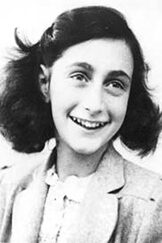
Anne Frank 1929-1945
Anne Frank is perhaps the most famous victim of the Holocaust and her diary, written when she was a teenager in hiding from the Nazis, helped spread understanding of the Holocaust around the world. She was born in Frankfurt in 1929 and came to Amsterdam with her family in 1933 following Hitler’s rise to power in Germany. Her parents Otto and Edith were liberal Jews. Anne and her sister Margot were educated in integrated schools until the Nazi occupation of the Netherlands in 1940, when all Jewish children were placed in Jewish-only educational institutions.
By 1942, the killing and deportation to the camps of Jews from the Netherlands had begun. Anne’s family, after unsuccessfully applying for refuge in America, went into hiding. They, with four other Jews, lived in what Anne called the “Secret Annex.” This was a small cove behind a bookcase in her father’s business premises.
Their only outside contact was with six trusted non-Jewish friends and employees of Otto’s who brought them provisions and news. The thirteen-year-old Anne spent much of her time writing in her diary. Her early entries focused on the German persecution of Jews but she also wrote, with growing maturity and skill, about her daily life, her relationships, feelings, and beliefs.
Her last diary entry was on August 1, 1944. Three days later, possibly after a tipoff by informants, the Secret Annex was discovered by German police. The Franks were interrogated, then sent to the Westerbork transit camp in northeast Netherlands. In September 1944, they and over 1,000 other Jews were crowded onto a cattle train and transported to Auschwitz-Birkenau. More than half of the members of the transport were gassed immediately upon arrival. Anne, her mother, and her sister were sent to a slave labor camp for women. Otto went to a male labor camp. Disease was rampant. Edith, who transferred nearly all her meager food rations to her seriously ill daughters, died of starvation. Anne and Margot were moved to the Bergen-Belsen concentration camp. They died there in 1945, probably due to a typhoid epidemic that ravaged the camp. Anne was 15 years old.
Anne had often written about her desire to be an author. Her father, Otto, the only member of the Secret Annex to survive the war, honored that wish. Anne’s diary, which had been rescued and kept safe by one of the family’s helpers, was published in Dutch in 1947 as The Secret Annex. As discussion of the Holocaust increased over the years, the diary’s readership grew into the millions. It was published in America as The Diary of a Young Girl and became part of the reading list for many schools.
The diary has been translated into over 70 languages and Anne is considered by many to be a symbol or embodiment of the tragedy of the Holocaust. Nonetheless, the importance of Anne Frank also lies in her individuality, in the power of her writing, and the honesty of her voice.
J2 STUFF.
We have everything you need to know before you go. Check out our Instagram my_j2adventures for cool updates and interesting tidbits.
The J2 App
available on the App Store & on Google Play.

START PLANNING LET’S EXPLORE.
Whether you have a journey in mind, want to join a featured trip, or simply want to explore, drop us a note. We work really hard to be a loved travel company that delivers amazing and memorable experiences. So please do not be surprised when we say “yes” to every reasonable request you make!
